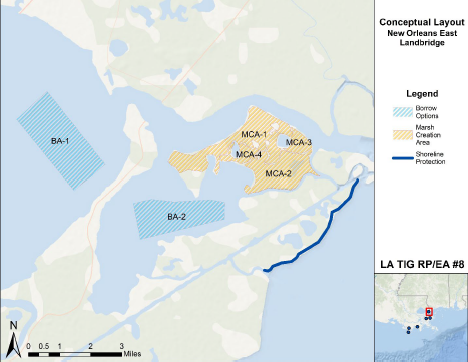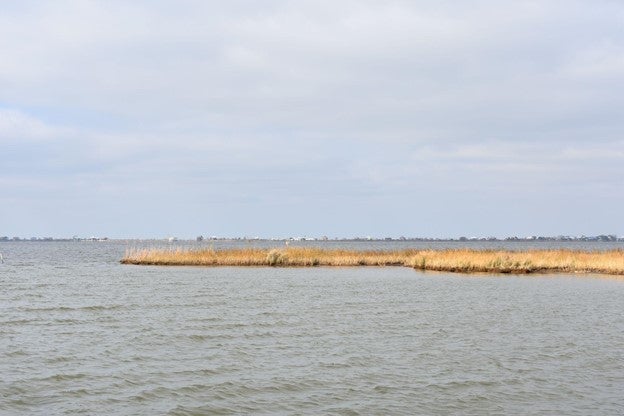This natural storm buffer helps protect Greater New Orleans. A new restoration project will prevent it from disappearing.
Recent hurricanes have demonstrated how vulnerable our region is to growing flood risk, and a recent technical report by NOAA underscores the threats posed by sea level rise. As seas rise, storms strengthen in intensity and wetlands disappear, Louisiana is in a race against time to maintain and restore coastal wetlands as critical natural buffers and lines of defense for communities and vital infrastructure.
Thankfully, a major coastal restoration project to restore and preserve one vital natural line of defense is moving forward. In March of 2022 the Louisiana Trustee Implementation Group released the “Draft Restoration Plan/Environmental Assessment #8: Restoration of Wetlands, Coastal, and Nearshore Habitats” which proposes several restoration projects that aim to restore wetlands and other coastal ecosystems damaged by the Deepwater Horizon oil spill. One of the six projects evaluated in the plan is the New Orleans East Landbridge, a restoration project that will restore a vital buffer for communities across the Greater New Orleans region from storm surge and sea level rise.
A critical natural line of defense for our communities.

East Orleans Landbridge Restoration Conceptual Layout, LA TIG Draft Restoration Plan/Environmental Assessment #8: Restoration of Wetland, Coastal, and Nearshore Habitats
Called a “Critical Landscape Feature” by the U.S. Army Corps of Engineers, the landbridge acts as a buffer for storm surge, slowing it down and reducing potential impacts for communities around Lake Pontchartrain and Lake Maurepas. Without action the landbridge is expected to disappear almost entirely over the next 50 years from repetitive storms, sea level rise and erosion. The stretch of land between New Orleans and Slidell includes Highway 90, one of only two eastward evacuation routes for New Orleans. This land also helps to control tidal flow between the Gulf of Mexico and Lake Pontchartrain, regulating the mix of fresh and salt water in the Lake and creating vital habitat throughout the entire basin for both commercially and ecologically important species such as blue crab, speckled trout, sturgeon and migratory waterfowl. Without restoration, the continued loss of the marshes that make up the landbridge will have an increasingly negative impact on a multitude of species and their habitat, resulting in decreased productivity for fisheries and diminished storm protection for the 1.5 million people that live around Lake Pontchartrain.
Learn more about the landbridge here.
A project to restore the landbridge takes a big step forward.
The Draft Restoration Plan #8 recommends approximately $4 million in funding for the engineering and design work necessary to advance the New Orleans East Landbridge toward eventual construction. While the importance of the New Orleans East Landbridge has been identified in the Louisiana Coastal Master Plan, the Mississippi River Gulf Outlet, Ecosystem Restoration Plan (USACE, 2012), the City of New Orleans Resilience Strategy, the Orleans Parish Hazard Mitigation Plan and by the interagency CWPPRA working group, no specific project design of this scale has been completed to-date. This is a critical and urgent step toward restoration and protection. Without engineering and design, the project is at risk of further delay and increased costs, as the demand and price for needed materials, including sediment, go up over time. This important preliminary work will be paid for with the Deepwater Horizon Settlement money being allocated by the Louisiana Trustee Implementation Group.
Read the full plan here.
Help move this critical project forward!
Restoration of the New Orleans East Landbridge has enjoyed broad public support from local governments, legislators, community-based nonprofits, sportsmen, restaurateurs, faith leaders, conservation organizations, scientists, business leaders, and concerned citizens and supporters like you! You can also join the chorus of supporters by providing a supportive comment during the public comment period. If you are interested in learning more about the landbridge please contact Samantha Carter at carters@nwf.org .
You can review and comment on the draft plan through April 18 by submitting comments online or by mail.
-
- Online: https://parkplanning.nps.gov/LATIG8
- By mail:
U.S. Fish and Wildlife Service
P.O. Box 29649
Atlanta, GA 30345
